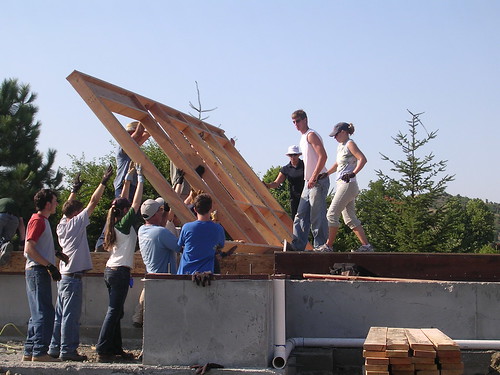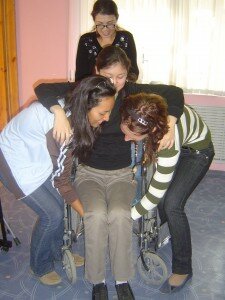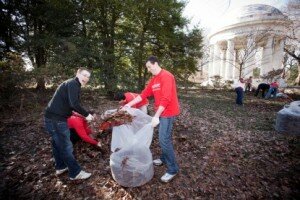 Have you ever found yourself saying, “I’ve always wanted to volunteer, but I don’t have the time,” or “I just don’t know where to start”?
Have you ever found yourself saying, “I’ve always wanted to volunteer, but I don’t have the time,” or “I just don’t know where to start”?
Challenge your definition of volunteering and you might just discover that you are doing it already! A volunteer, to put simply, is someone who gives his or her time willingly and expects nothing in return.
Have you ever helped a friend write a letter or a job application? Have you helped at your child’s school with an outing, at a book sale to raise money, or a community sports event? Ever “paid it forward” and committed a random act of kindness like helping a stranger with his or her suitcase at the airport? These acts are all forms of volunteering. I bet you didn’t even notice the time it took out of your day!
If time is short but you want to get involved, lending a hand can become a way of life. Here are six quick and easy ways to volunteer and start making a difference.
• Multitask!
You have to go food shopping. Why not call an elderly neighbor, or someone who can’t get out, and do his or her shopping? How about picking up a few cans for your local food bank? You are going anyway!
• Like to chat?
Do you have 30 minutes to spare, maybe once a week, and access to Facebook? Check out . You could partner up with someone wanting to learn your language and maybe learn his or hers, too.
 • Throw a swap party!
• Throw a swap party!
Grab your friends for an hour and have a swap party. Choose a theme (books, clothes, toys, etc.). You might come away with something you didn’t know you needed, and all of those unused items will be recycled as something someone didn’t know they needed. All the unclaimed items can be donated to the charity of your choice.
• Are you a gamer?
Did you know that you can play online games for free that donate to charities on your behalf? One example is Charitii – a charity-donating crossword Web site that raises money to provide clean water, food for the malnourished, and protection of the rainforest worldwide.
• Utilize your own connections
If there is a cause that really means something to you, you can help raise awareness of its work using your own network. You never know who might be listening who can help! Colleagues at work, friends and family, acquaintances that you find yourself chatting with – help spread the word by talking to people. If you have time free during your lunch hour, maybe that charity needs help writing e-mails or posters that need to be put up. Why not write to your newspaper to tell of the good work that the charity does?
• Do what you know!
If you can cook, you can help. If you can read, you can help. Are you a computer programmer? A nurse? There are countless ways of using your existing skills to benefit others. Cook someone a meal, advise on health matters, fix a computer for an elderly neighbor or underfunded organization. Become aware of the people around you and figure out how much time you can spare each month. Even half an hour can make a huge difference for those who could benefit from your skills.
These are just a few small ways of donating a little bit of your time to help others. They are all unique volunteer activities and there are hundreds of more options out there. Small acts of kindness count, and add up overtime!
How do you volunteer in short time periods? Let us know in the comments below!



 An important part of volunteer engagement is equipping volunteers for their tasks. You want to ensure they have the knowledge, skills, and attitudes to serve successfully. Additionally, many volunteers view service as a way to develop or improve skills, so training is a way to further their personal and professional development.
An important part of volunteer engagement is equipping volunteers for their tasks. You want to ensure they have the knowledge, skills, and attitudes to serve successfully. Additionally, many volunteers view service as a way to develop or improve skills, so training is a way to further their personal and professional development. This past week has been a difficult one for Colorado residents. Large wildfires and high temperatures have destroyed thousands of homes, forcing residents to evacuate their communities to find safe shelter. Although many people and organizations are helping the relief efforts, they still need more help!
This past week has been a difficult one for Colorado residents. Large wildfires and high temperatures have destroyed thousands of homes, forcing residents to evacuate their communities to find safe shelter. Although many people and organizations are helping the relief efforts, they still need more help! this time. The list includes:
this time. The list includes:
 Colorado needs our help at this time. Come together with your community and help support them in their efforts.
Colorado needs our help at this time. Come together with your community and help support them in their efforts. Today’s post comes from Gregg Michaelsen, Fundraising Consultant at Simple Fundraising Ideas. Gregg specializes in providing
Today’s post comes from Gregg Michaelsen, Fundraising Consultant at Simple Fundraising Ideas. Gregg specializes in providing  banner in the fundraiser’s venue with the restaurant’s information on it.
banner in the fundraiser’s venue with the restaurant’s information on it. Visit a hospitalized veteran or a veteran living in a veteran’s home! Why wouldn’t a veteran appreciate someone taking the time out of their day to come and visit them in the hospital to remind them that they are grateful for their service to our country!
Visit a hospitalized veteran or a veteran living in a veteran’s home! Why wouldn’t a veteran appreciate someone taking the time out of their day to come and visit them in the hospital to remind them that they are grateful for their service to our country!


 community?
community? of getting the word out and who needs to be contacted.
of getting the word out and who needs to be contacted.


